Code of Conduct: Analysis for National Australia Bank (NAB)
VerifiedAdded on 2023/02/01
|10
|2473
|28
Report
AI Summary
This report provides a comprehensive analysis of the Code of Conduct for the National Australia Bank (NAB). It delves into the bank's internal guidelines and principles, emphasizing honesty, accountability, and ethical conduct. The report explores key aspects of the code, including its commitment to stakeholders, customers, and employees, and the promotion of fair and respectful treatment. It examines the bank's adherence to ethical standards, regulatory obligations, and commitments related to discrimination, exploitation, corruption, dishonest behavior, whistleblower protection, and enforcement. The analysis highlights NAB's dedication to a safe and healthy environment, its efforts to prevent fraud and corruption, and its commitment to protecting confidential information. The report concludes by summarizing the key principles of the code and its importance in guiding the bank's operations and interactions with various stakeholders.
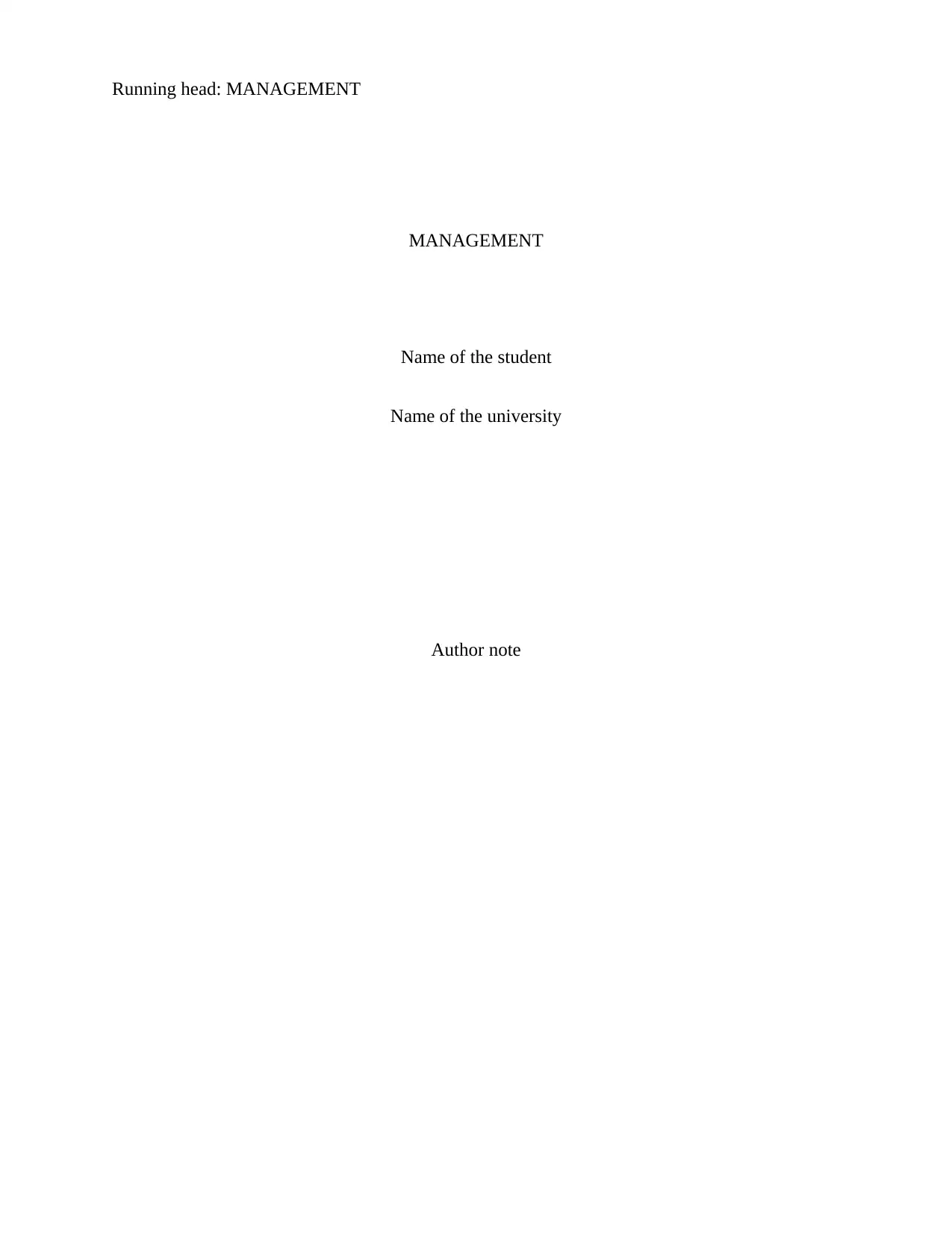
Running head: MANAGEMENT
MANAGEMENT
Name of the student
Name of the university
Author note
MANAGEMENT
Name of the student
Name of the university
Author note
Paraphrase This Document
Need a fresh take? Get an instant paraphrase of this document with our AI Paraphraser
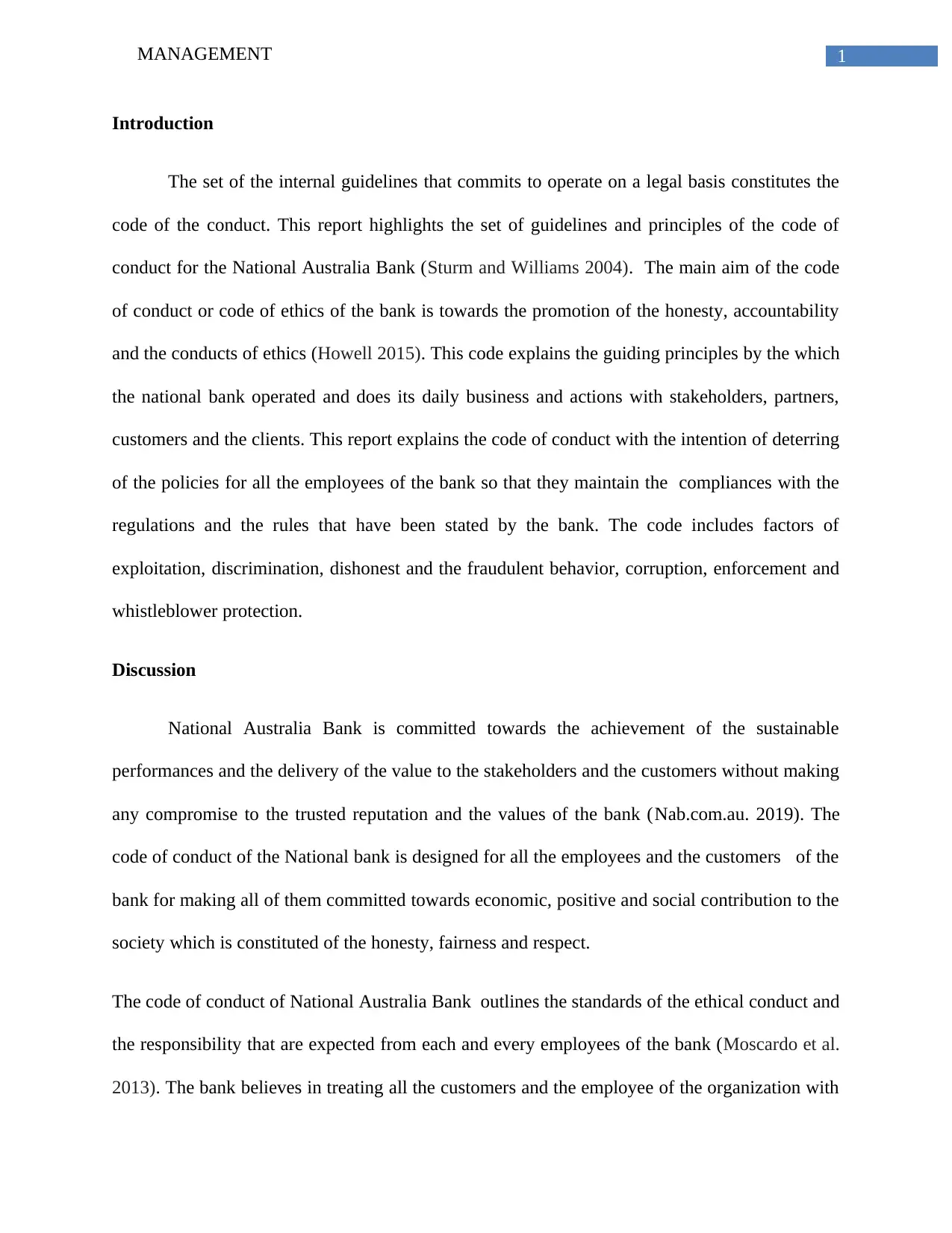
1MANAGEMENT
Introduction
The set of the internal guidelines that commits to operate on a legal basis constitutes the
code of the conduct. This report highlights the set of guidelines and principles of the code of
conduct for the National Australia Bank (Sturm and Williams 2004). The main aim of the code
of conduct or code of ethics of the bank is towards the promotion of the honesty, accountability
and the conducts of ethics (Howell 2015). This code explains the guiding principles by the which
the national bank operated and does its daily business and actions with stakeholders, partners,
customers and the clients. This report explains the code of conduct with the intention of deterring
of the policies for all the employees of the bank so that they maintain the compliances with the
regulations and the rules that have been stated by the bank. The code includes factors of
exploitation, discrimination, dishonest and the fraudulent behavior, corruption, enforcement and
whistleblower protection.
Discussion
National Australia Bank is committed towards the achievement of the sustainable
performances and the delivery of the value to the stakeholders and the customers without making
any compromise to the trusted reputation and the values of the bank (Nab.com.au. 2019). The
code of conduct of the National bank is designed for all the employees and the customers of the
bank for making all of them committed towards economic, positive and social contribution to the
society which is constituted of the honesty, fairness and respect.
The code of conduct of National Australia Bank outlines the standards of the ethical conduct and
the responsibility that are expected from each and every employees of the bank (Moscardo et al.
2013). The bank believes in treating all the customers and the employee of the organization with
Introduction
The set of the internal guidelines that commits to operate on a legal basis constitutes the
code of the conduct. This report highlights the set of guidelines and principles of the code of
conduct for the National Australia Bank (Sturm and Williams 2004). The main aim of the code
of conduct or code of ethics of the bank is towards the promotion of the honesty, accountability
and the conducts of ethics (Howell 2015). This code explains the guiding principles by the which
the national bank operated and does its daily business and actions with stakeholders, partners,
customers and the clients. This report explains the code of conduct with the intention of deterring
of the policies for all the employees of the bank so that they maintain the compliances with the
regulations and the rules that have been stated by the bank. The code includes factors of
exploitation, discrimination, dishonest and the fraudulent behavior, corruption, enforcement and
whistleblower protection.
Discussion
National Australia Bank is committed towards the achievement of the sustainable
performances and the delivery of the value to the stakeholders and the customers without making
any compromise to the trusted reputation and the values of the bank (Nab.com.au. 2019). The
code of conduct of the National bank is designed for all the employees and the customers of the
bank for making all of them committed towards economic, positive and social contribution to the
society which is constituted of the honesty, fairness and respect.
The code of conduct of National Australia Bank outlines the standards of the ethical conduct and
the responsibility that are expected from each and every employees of the bank (Moscardo et al.
2013). The bank believes in treating all the customers and the employee of the organization with
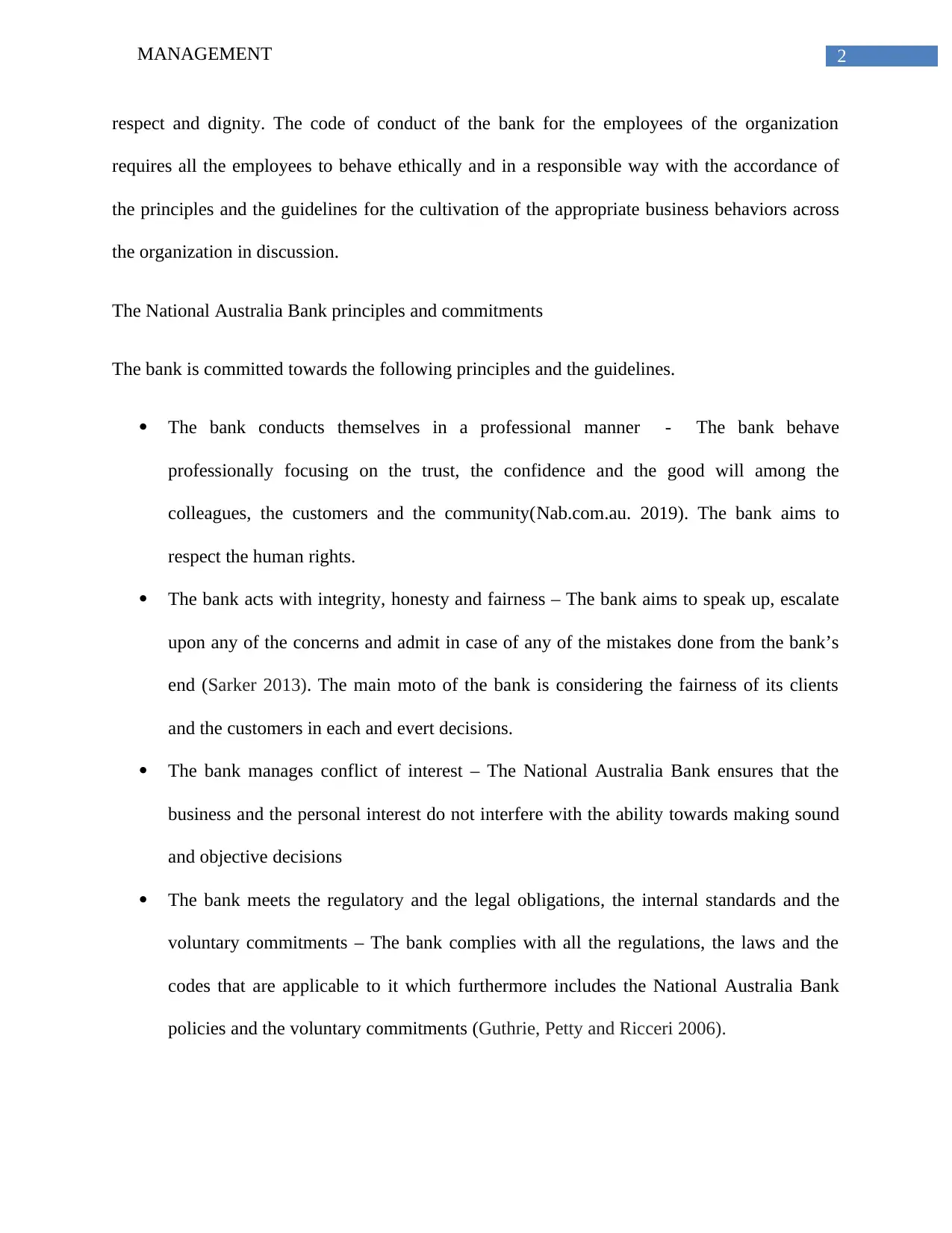
2MANAGEMENT
respect and dignity. The code of conduct of the bank for the employees of the organization
requires all the employees to behave ethically and in a responsible way with the accordance of
the principles and the guidelines for the cultivation of the appropriate business behaviors across
the organization in discussion.
The National Australia Bank principles and commitments
The bank is committed towards the following principles and the guidelines.
The bank conducts themselves in a professional manner - The bank behave
professionally focusing on the trust, the confidence and the good will among the
colleagues, the customers and the community(Nab.com.au. 2019). The bank aims to
respect the human rights.
The bank acts with integrity, honesty and fairness – The bank aims to speak up, escalate
upon any of the concerns and admit in case of any of the mistakes done from the bank’s
end (Sarker 2013). The main moto of the bank is considering the fairness of its clients
and the customers in each and evert decisions.
The bank manages conflict of interest – The National Australia Bank ensures that the
business and the personal interest do not interfere with the ability towards making sound
and objective decisions
The bank meets the regulatory and the legal obligations, the internal standards and the
voluntary commitments – The bank complies with all the regulations, the laws and the
codes that are applicable to it which furthermore includes the National Australia Bank
policies and the voluntary commitments (Guthrie, Petty and Ricceri 2006).
respect and dignity. The code of conduct of the bank for the employees of the organization
requires all the employees to behave ethically and in a responsible way with the accordance of
the principles and the guidelines for the cultivation of the appropriate business behaviors across
the organization in discussion.
The National Australia Bank principles and commitments
The bank is committed towards the following principles and the guidelines.
The bank conducts themselves in a professional manner - The bank behave
professionally focusing on the trust, the confidence and the good will among the
colleagues, the customers and the community(Nab.com.au. 2019). The bank aims to
respect the human rights.
The bank acts with integrity, honesty and fairness – The bank aims to speak up, escalate
upon any of the concerns and admit in case of any of the mistakes done from the bank’s
end (Sarker 2013). The main moto of the bank is considering the fairness of its clients
and the customers in each and evert decisions.
The bank manages conflict of interest – The National Australia Bank ensures that the
business and the personal interest do not interfere with the ability towards making sound
and objective decisions
The bank meets the regulatory and the legal obligations, the internal standards and the
voluntary commitments – The bank complies with all the regulations, the laws and the
codes that are applicable to it which furthermore includes the National Australia Bank
policies and the voluntary commitments (Guthrie, Petty and Ricceri 2006).
⊘ This is a preview!⊘
Do you want full access?
Subscribe today to unlock all pages.

Trusted by 1+ million students worldwide
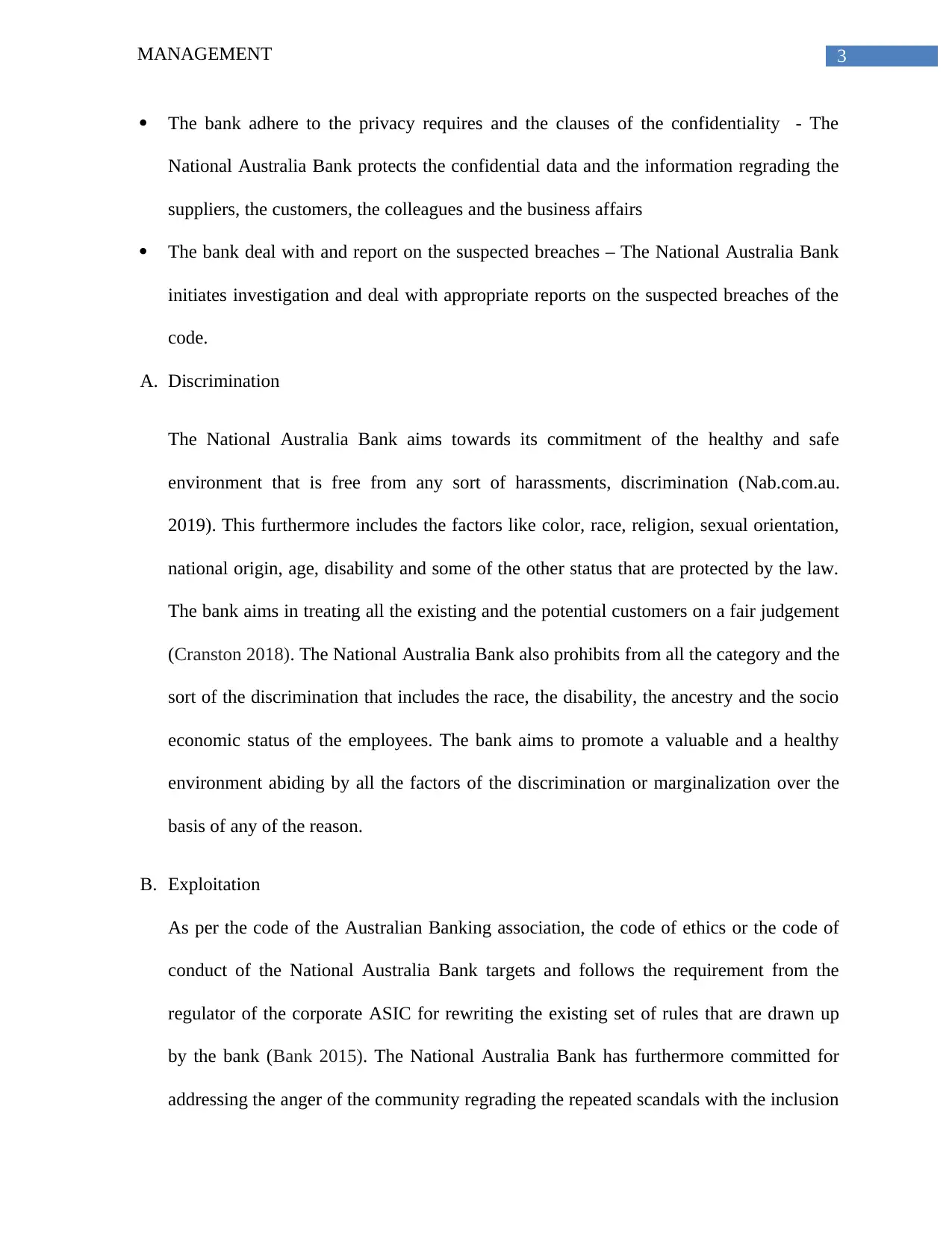
3MANAGEMENT
The bank adhere to the privacy requires and the clauses of the confidentiality - The
National Australia Bank protects the confidential data and the information regrading the
suppliers, the customers, the colleagues and the business affairs
The bank deal with and report on the suspected breaches – The National Australia Bank
initiates investigation and deal with appropriate reports on the suspected breaches of the
code.
A. Discrimination
The National Australia Bank aims towards its commitment of the healthy and safe
environment that is free from any sort of harassments, discrimination (Nab.com.au.
2019). This furthermore includes the factors like color, race, religion, sexual orientation,
national origin, age, disability and some of the other status that are protected by the law.
The bank aims in treating all the existing and the potential customers on a fair judgement
(Cranston 2018). The National Australia Bank also prohibits from all the category and the
sort of the discrimination that includes the race, the disability, the ancestry and the socio
economic status of the employees. The bank aims to promote a valuable and a healthy
environment abiding by all the factors of the discrimination or marginalization over the
basis of any of the reason.
B. Exploitation
As per the code of the Australian Banking association, the code of ethics or the code of
conduct of the National Australia Bank targets and follows the requirement from the
regulator of the corporate ASIC for rewriting the existing set of rules that are drawn up
by the bank (Bank 2015). The National Australia Bank has furthermore committed for
addressing the anger of the community regrading the repeated scandals with the inclusion
The bank adhere to the privacy requires and the clauses of the confidentiality - The
National Australia Bank protects the confidential data and the information regrading the
suppliers, the customers, the colleagues and the business affairs
The bank deal with and report on the suspected breaches – The National Australia Bank
initiates investigation and deal with appropriate reports on the suspected breaches of the
code.
A. Discrimination
The National Australia Bank aims towards its commitment of the healthy and safe
environment that is free from any sort of harassments, discrimination (Nab.com.au.
2019). This furthermore includes the factors like color, race, religion, sexual orientation,
national origin, age, disability and some of the other status that are protected by the law.
The bank aims in treating all the existing and the potential customers on a fair judgement
(Cranston 2018). The National Australia Bank also prohibits from all the category and the
sort of the discrimination that includes the race, the disability, the ancestry and the socio
economic status of the employees. The bank aims to promote a valuable and a healthy
environment abiding by all the factors of the discrimination or marginalization over the
basis of any of the reason.
B. Exploitation
As per the code of the Australian Banking association, the code of ethics or the code of
conduct of the National Australia Bank targets and follows the requirement from the
regulator of the corporate ASIC for rewriting the existing set of rules that are drawn up
by the bank (Bank 2015). The National Australia Bank has furthermore committed for
addressing the anger of the community regrading the repeated scandals with the inclusion
Paraphrase This Document
Need a fresh take? Get an instant paraphrase of this document with our AI Paraphraser
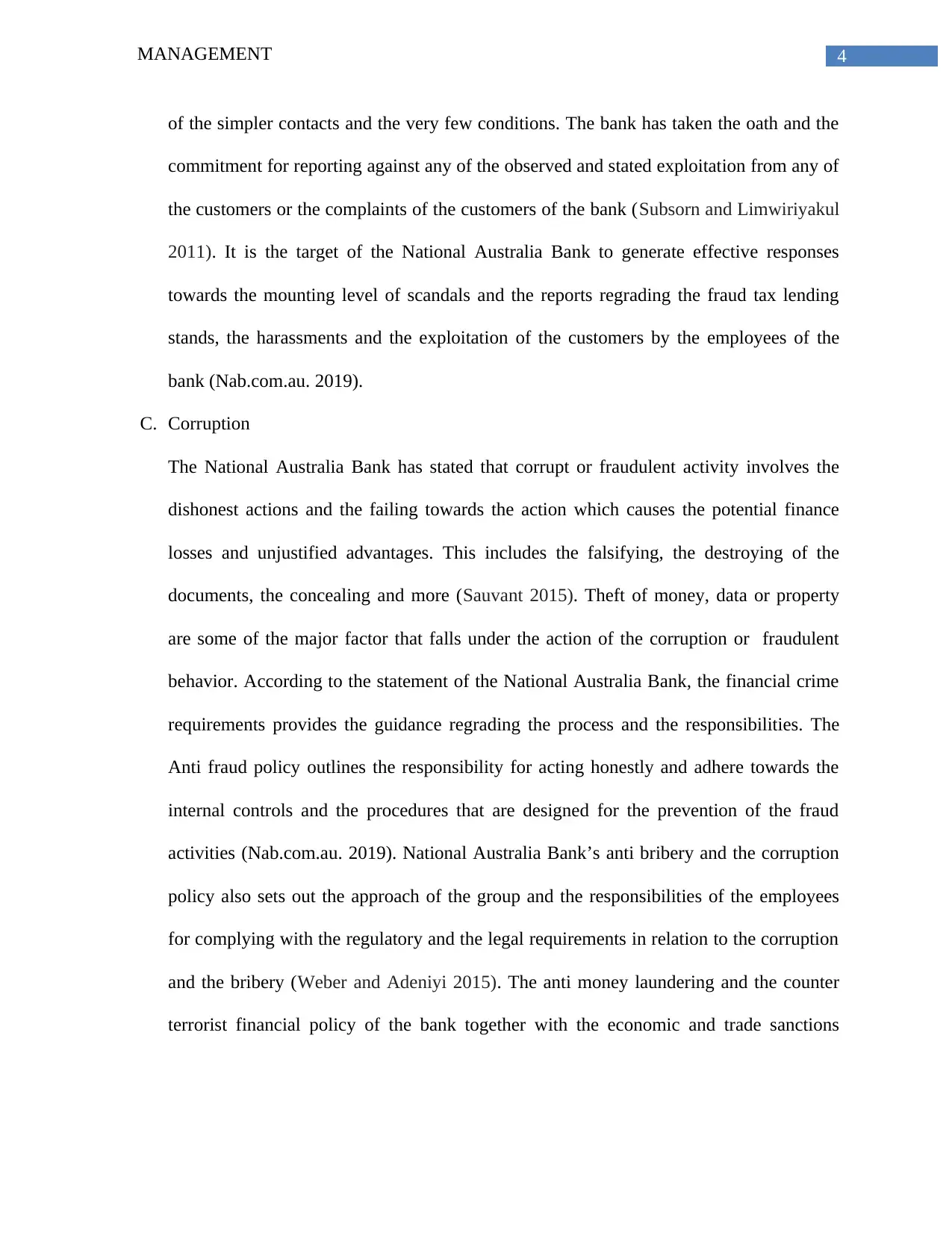
4MANAGEMENT
of the simpler contacts and the very few conditions. The bank has taken the oath and the
commitment for reporting against any of the observed and stated exploitation from any of
the customers or the complaints of the customers of the bank (Subsorn and Limwiriyakul
2011). It is the target of the National Australia Bank to generate effective responses
towards the mounting level of scandals and the reports regrading the fraud tax lending
stands, the harassments and the exploitation of the customers by the employees of the
bank (Nab.com.au. 2019).
C. Corruption
The National Australia Bank has stated that corrupt or fraudulent activity involves the
dishonest actions and the failing towards the action which causes the potential finance
losses and unjustified advantages. This includes the falsifying, the destroying of the
documents, the concealing and more (Sauvant 2015). Theft of money, data or property
are some of the major factor that falls under the action of the corruption or fraudulent
behavior. According to the statement of the National Australia Bank, the financial crime
requirements provides the guidance regrading the process and the responsibilities. The
Anti fraud policy outlines the responsibility for acting honestly and adhere towards the
internal controls and the procedures that are designed for the prevention of the fraud
activities (Nab.com.au. 2019). National Australia Bank’s anti bribery and the corruption
policy also sets out the approach of the group and the responsibilities of the employees
for complying with the regulatory and the legal requirements in relation to the corruption
and the bribery (Weber and Adeniyi 2015). The anti money laundering and the counter
terrorist financial policy of the bank together with the economic and trade sanctions
of the simpler contacts and the very few conditions. The bank has taken the oath and the
commitment for reporting against any of the observed and stated exploitation from any of
the customers or the complaints of the customers of the bank (Subsorn and Limwiriyakul
2011). It is the target of the National Australia Bank to generate effective responses
towards the mounting level of scandals and the reports regrading the fraud tax lending
stands, the harassments and the exploitation of the customers by the employees of the
bank (Nab.com.au. 2019).
C. Corruption
The National Australia Bank has stated that corrupt or fraudulent activity involves the
dishonest actions and the failing towards the action which causes the potential finance
losses and unjustified advantages. This includes the falsifying, the destroying of the
documents, the concealing and more (Sauvant 2015). Theft of money, data or property
are some of the major factor that falls under the action of the corruption or fraudulent
behavior. According to the statement of the National Australia Bank, the financial crime
requirements provides the guidance regrading the process and the responsibilities. The
Anti fraud policy outlines the responsibility for acting honestly and adhere towards the
internal controls and the procedures that are designed for the prevention of the fraud
activities (Nab.com.au. 2019). National Australia Bank’s anti bribery and the corruption
policy also sets out the approach of the group and the responsibilities of the employees
for complying with the regulatory and the legal requirements in relation to the corruption
and the bribery (Weber and Adeniyi 2015). The anti money laundering and the counter
terrorist financial policy of the bank together with the economic and trade sanctions
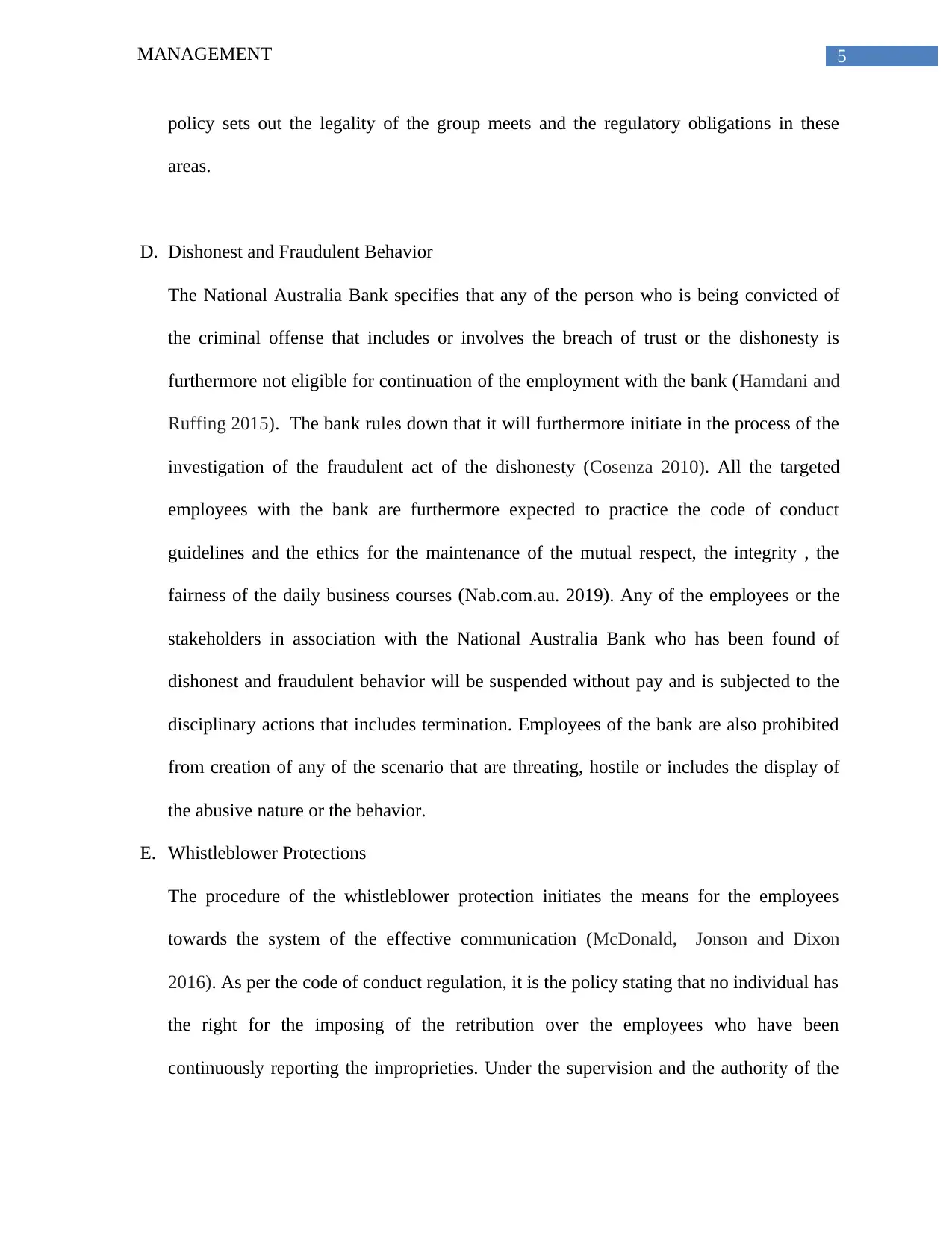
5MANAGEMENT
policy sets out the legality of the group meets and the regulatory obligations in these
areas.
D. Dishonest and Fraudulent Behavior
The National Australia Bank specifies that any of the person who is being convicted of
the criminal offense that includes or involves the breach of trust or the dishonesty is
furthermore not eligible for continuation of the employment with the bank (Hamdani and
Ruffing 2015). The bank rules down that it will furthermore initiate in the process of the
investigation of the fraudulent act of the dishonesty (Cosenza 2010). All the targeted
employees with the bank are furthermore expected to practice the code of conduct
guidelines and the ethics for the maintenance of the mutual respect, the integrity , the
fairness of the daily business courses (Nab.com.au. 2019). Any of the employees or the
stakeholders in association with the National Australia Bank who has been found of
dishonest and fraudulent behavior will be suspended without pay and is subjected to the
disciplinary actions that includes termination. Employees of the bank are also prohibited
from creation of any of the scenario that are threating, hostile or includes the display of
the abusive nature or the behavior.
E. Whistleblower Protections
The procedure of the whistleblower protection initiates the means for the employees
towards the system of the effective communication (McDonald, Jonson and Dixon
2016). As per the code of conduct regulation, it is the policy stating that no individual has
the right for the imposing of the retribution over the employees who have been
continuously reporting the improprieties. Under the supervision and the authority of the
policy sets out the legality of the group meets and the regulatory obligations in these
areas.
D. Dishonest and Fraudulent Behavior
The National Australia Bank specifies that any of the person who is being convicted of
the criminal offense that includes or involves the breach of trust or the dishonesty is
furthermore not eligible for continuation of the employment with the bank (Hamdani and
Ruffing 2015). The bank rules down that it will furthermore initiate in the process of the
investigation of the fraudulent act of the dishonesty (Cosenza 2010). All the targeted
employees with the bank are furthermore expected to practice the code of conduct
guidelines and the ethics for the maintenance of the mutual respect, the integrity , the
fairness of the daily business courses (Nab.com.au. 2019). Any of the employees or the
stakeholders in association with the National Australia Bank who has been found of
dishonest and fraudulent behavior will be suspended without pay and is subjected to the
disciplinary actions that includes termination. Employees of the bank are also prohibited
from creation of any of the scenario that are threating, hostile or includes the display of
the abusive nature or the behavior.
E. Whistleblower Protections
The procedure of the whistleblower protection initiates the means for the employees
towards the system of the effective communication (McDonald, Jonson and Dixon
2016). As per the code of conduct regulation, it is the policy stating that no individual has
the right for the imposing of the retribution over the employees who have been
continuously reporting the improprieties. Under the supervision and the authority of the
⊘ This is a preview!⊘
Do you want full access?
Subscribe today to unlock all pages.

Trusted by 1+ million students worldwide
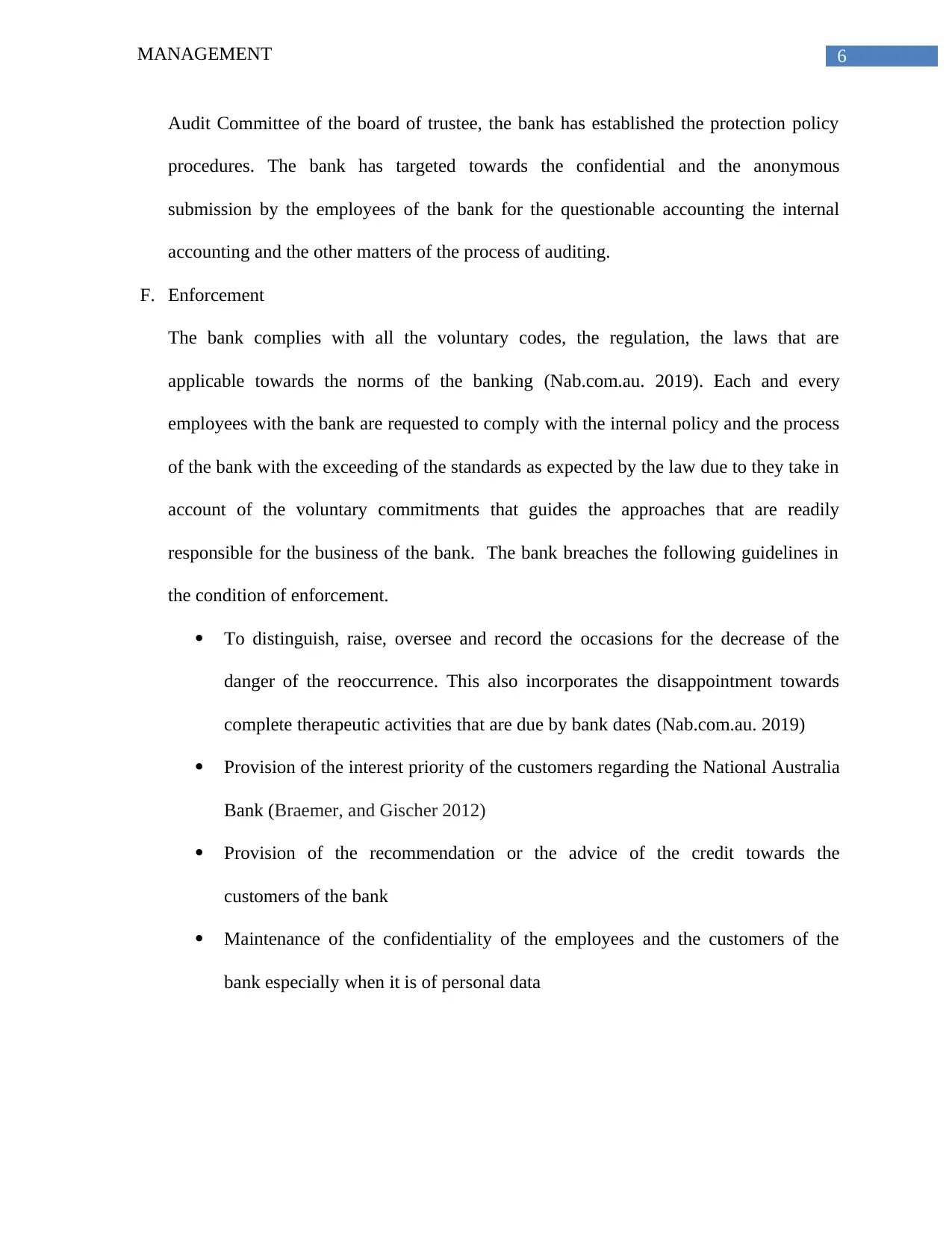
6MANAGEMENT
Audit Committee of the board of trustee, the bank has established the protection policy
procedures. The bank has targeted towards the confidential and the anonymous
submission by the employees of the bank for the questionable accounting the internal
accounting and the other matters of the process of auditing.
F. Enforcement
The bank complies with all the voluntary codes, the regulation, the laws that are
applicable towards the norms of the banking (Nab.com.au. 2019). Each and every
employees with the bank are requested to comply with the internal policy and the process
of the bank with the exceeding of the standards as expected by the law due to they take in
account of the voluntary commitments that guides the approaches that are readily
responsible for the business of the bank. The bank breaches the following guidelines in
the condition of enforcement.
To distinguish, raise, oversee and record the occasions for the decrease of the
danger of the reoccurrence. This also incorporates the disappointment towards
complete therapeutic activities that are due by bank dates (Nab.com.au. 2019)
Provision of the interest priority of the customers regarding the National Australia
Bank (Braemer, and Gischer 2012)
Provision of the recommendation or the advice of the credit towards the
customers of the bank
Maintenance of the confidentiality of the employees and the customers of the
bank especially when it is of personal data
Audit Committee of the board of trustee, the bank has established the protection policy
procedures. The bank has targeted towards the confidential and the anonymous
submission by the employees of the bank for the questionable accounting the internal
accounting and the other matters of the process of auditing.
F. Enforcement
The bank complies with all the voluntary codes, the regulation, the laws that are
applicable towards the norms of the banking (Nab.com.au. 2019). Each and every
employees with the bank are requested to comply with the internal policy and the process
of the bank with the exceeding of the standards as expected by the law due to they take in
account of the voluntary commitments that guides the approaches that are readily
responsible for the business of the bank. The bank breaches the following guidelines in
the condition of enforcement.
To distinguish, raise, oversee and record the occasions for the decrease of the
danger of the reoccurrence. This also incorporates the disappointment towards
complete therapeutic activities that are due by bank dates (Nab.com.au. 2019)
Provision of the interest priority of the customers regarding the National Australia
Bank (Braemer, and Gischer 2012)
Provision of the recommendation or the advice of the credit towards the
customers of the bank
Maintenance of the confidentiality of the employees and the customers of the
bank especially when it is of personal data
Paraphrase This Document
Need a fresh take? Get an instant paraphrase of this document with our AI Paraphraser
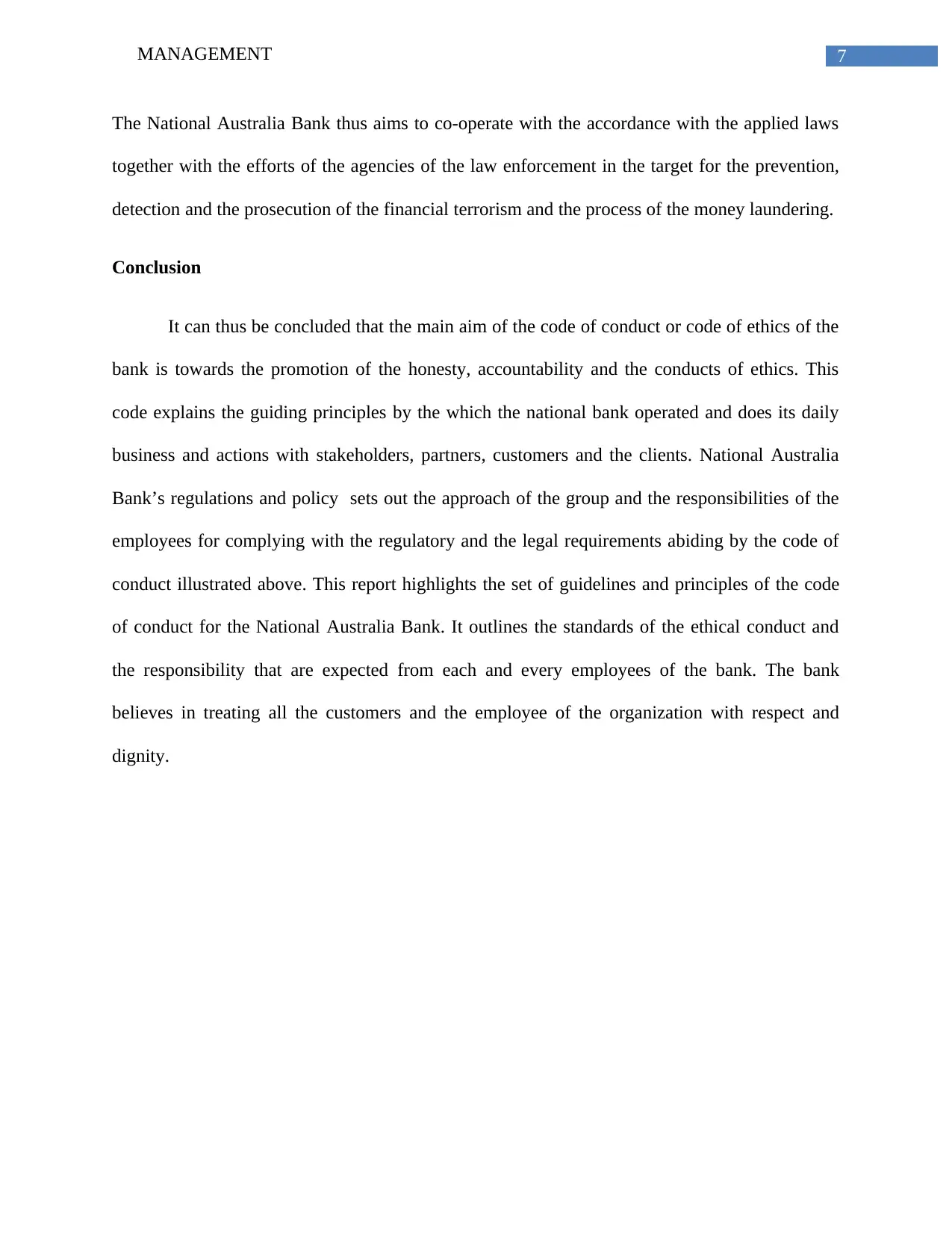
7MANAGEMENT
The National Australia Bank thus aims to co-operate with the accordance with the applied laws
together with the efforts of the agencies of the law enforcement in the target for the prevention,
detection and the prosecution of the financial terrorism and the process of the money laundering.
Conclusion
It can thus be concluded that the main aim of the code of conduct or code of ethics of the
bank is towards the promotion of the honesty, accountability and the conducts of ethics. This
code explains the guiding principles by the which the national bank operated and does its daily
business and actions with stakeholders, partners, customers and the clients. National Australia
Bank’s regulations and policy sets out the approach of the group and the responsibilities of the
employees for complying with the regulatory and the legal requirements abiding by the code of
conduct illustrated above. This report highlights the set of guidelines and principles of the code
of conduct for the National Australia Bank. It outlines the standards of the ethical conduct and
the responsibility that are expected from each and every employees of the bank. The bank
believes in treating all the customers and the employee of the organization with respect and
dignity.
The National Australia Bank thus aims to co-operate with the accordance with the applied laws
together with the efforts of the agencies of the law enforcement in the target for the prevention,
detection and the prosecution of the financial terrorism and the process of the money laundering.
Conclusion
It can thus be concluded that the main aim of the code of conduct or code of ethics of the
bank is towards the promotion of the honesty, accountability and the conducts of ethics. This
code explains the guiding principles by the which the national bank operated and does its daily
business and actions with stakeholders, partners, customers and the clients. National Australia
Bank’s regulations and policy sets out the approach of the group and the responsibilities of the
employees for complying with the regulatory and the legal requirements abiding by the code of
conduct illustrated above. This report highlights the set of guidelines and principles of the code
of conduct for the National Australia Bank. It outlines the standards of the ethical conduct and
the responsibility that are expected from each and every employees of the bank. The bank
believes in treating all the customers and the employee of the organization with respect and
dignity.
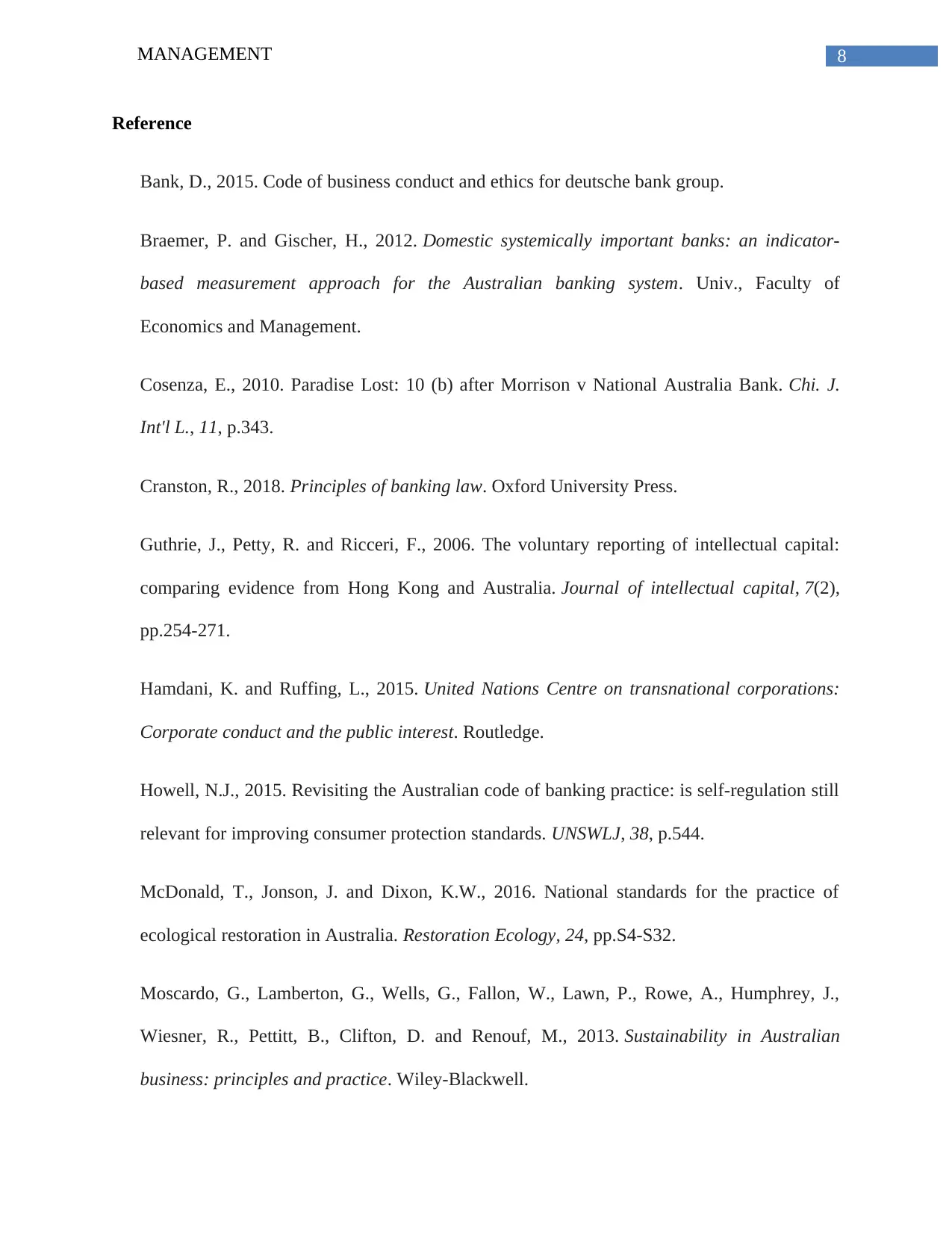
8MANAGEMENT
Reference
Bank, D., 2015. Code of business conduct and ethics for deutsche bank group.
Braemer, P. and Gischer, H., 2012. Domestic systemically important banks: an indicator-
based measurement approach for the Australian banking system. Univ., Faculty of
Economics and Management.
Cosenza, E., 2010. Paradise Lost: 10 (b) after Morrison v National Australia Bank. Chi. J.
Int'l L., 11, p.343.
Cranston, R., 2018. Principles of banking law. Oxford University Press.
Guthrie, J., Petty, R. and Ricceri, F., 2006. The voluntary reporting of intellectual capital:
comparing evidence from Hong Kong and Australia. Journal of intellectual capital, 7(2),
pp.254-271.
Hamdani, K. and Ruffing, L., 2015. United Nations Centre on transnational corporations:
Corporate conduct and the public interest. Routledge.
Howell, N.J., 2015. Revisiting the Australian code of banking practice: is self-regulation still
relevant for improving consumer protection standards. UNSWLJ, 38, p.544.
McDonald, T., Jonson, J. and Dixon, K.W., 2016. National standards for the practice of
ecological restoration in Australia. Restoration Ecology, 24, pp.S4-S32.
Moscardo, G., Lamberton, G., Wells, G., Fallon, W., Lawn, P., Rowe, A., Humphrey, J.,
Wiesner, R., Pettitt, B., Clifton, D. and Renouf, M., 2013. Sustainability in Australian
business: principles and practice. Wiley-Blackwell.
Reference
Bank, D., 2015. Code of business conduct and ethics for deutsche bank group.
Braemer, P. and Gischer, H., 2012. Domestic systemically important banks: an indicator-
based measurement approach for the Australian banking system. Univ., Faculty of
Economics and Management.
Cosenza, E., 2010. Paradise Lost: 10 (b) after Morrison v National Australia Bank. Chi. J.
Int'l L., 11, p.343.
Cranston, R., 2018. Principles of banking law. Oxford University Press.
Guthrie, J., Petty, R. and Ricceri, F., 2006. The voluntary reporting of intellectual capital:
comparing evidence from Hong Kong and Australia. Journal of intellectual capital, 7(2),
pp.254-271.
Hamdani, K. and Ruffing, L., 2015. United Nations Centre on transnational corporations:
Corporate conduct and the public interest. Routledge.
Howell, N.J., 2015. Revisiting the Australian code of banking practice: is self-regulation still
relevant for improving consumer protection standards. UNSWLJ, 38, p.544.
McDonald, T., Jonson, J. and Dixon, K.W., 2016. National standards for the practice of
ecological restoration in Australia. Restoration Ecology, 24, pp.S4-S32.
Moscardo, G., Lamberton, G., Wells, G., Fallon, W., Lawn, P., Rowe, A., Humphrey, J.,
Wiesner, R., Pettitt, B., Clifton, D. and Renouf, M., 2013. Sustainability in Australian
business: principles and practice. Wiley-Blackwell.
⊘ This is a preview!⊘
Do you want full access?
Subscribe today to unlock all pages.

Trusted by 1+ million students worldwide
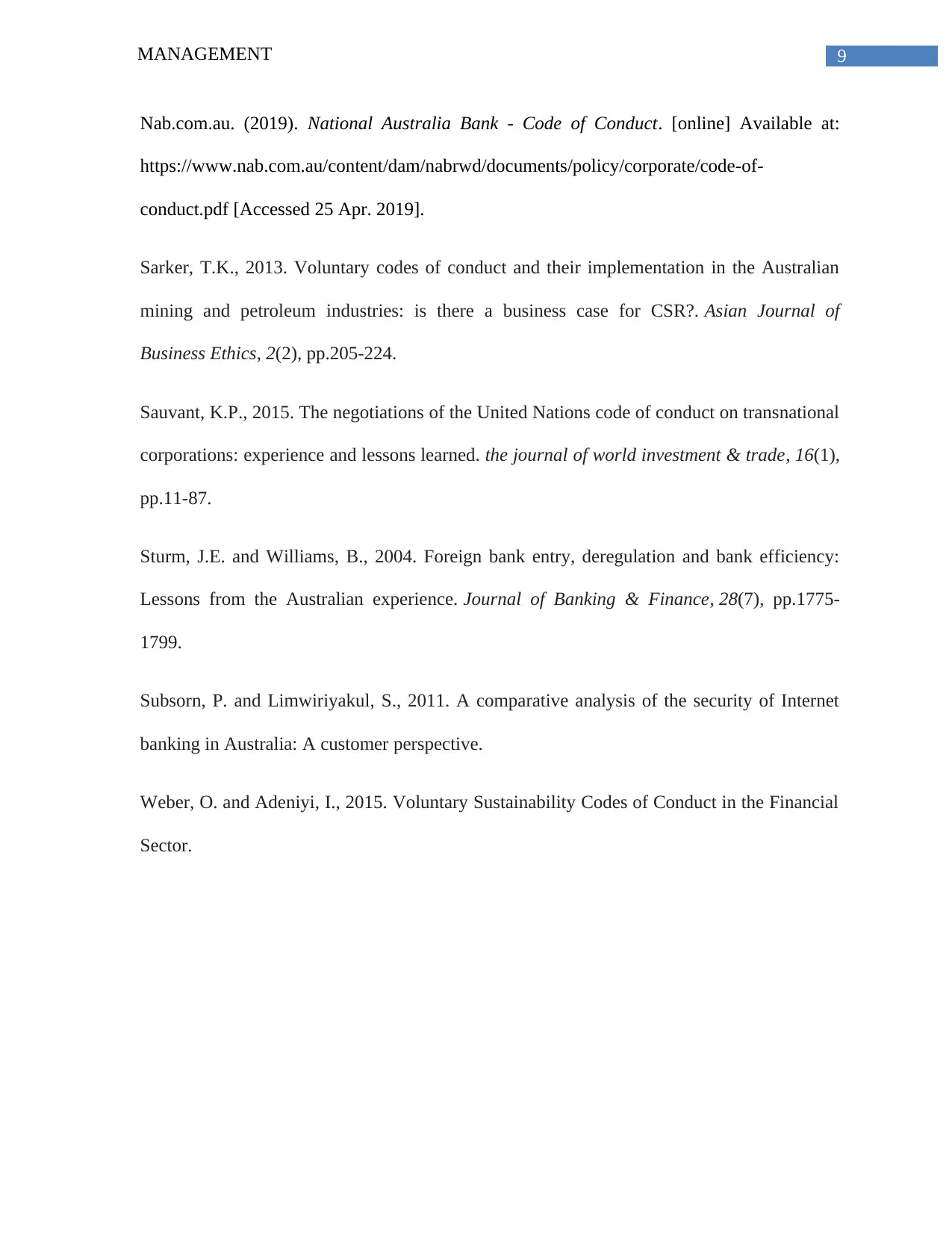
9MANAGEMENT
Nab.com.au. (2019). National Australia Bank - Code of Conduct. [online] Available at:
https://www.nab.com.au/content/dam/nabrwd/documents/policy/corporate/code-of-
conduct.pdf [Accessed 25 Apr. 2019].
Sarker, T.K., 2013. Voluntary codes of conduct and their implementation in the Australian
mining and petroleum industries: is there a business case for CSR?. Asian Journal of
Business Ethics, 2(2), pp.205-224.
Sauvant, K.P., 2015. The negotiations of the United Nations code of conduct on transnational
corporations: experience and lessons learned. the journal of world investment & trade, 16(1),
pp.11-87.
Sturm, J.E. and Williams, B., 2004. Foreign bank entry, deregulation and bank efficiency:
Lessons from the Australian experience. Journal of Banking & Finance, 28(7), pp.1775-
1799.
Subsorn, P. and Limwiriyakul, S., 2011. A comparative analysis of the security of Internet
banking in Australia: A customer perspective.
Weber, O. and Adeniyi, I., 2015. Voluntary Sustainability Codes of Conduct in the Financial
Sector.
Nab.com.au. (2019). National Australia Bank - Code of Conduct. [online] Available at:
https://www.nab.com.au/content/dam/nabrwd/documents/policy/corporate/code-of-
conduct.pdf [Accessed 25 Apr. 2019].
Sarker, T.K., 2013. Voluntary codes of conduct and their implementation in the Australian
mining and petroleum industries: is there a business case for CSR?. Asian Journal of
Business Ethics, 2(2), pp.205-224.
Sauvant, K.P., 2015. The negotiations of the United Nations code of conduct on transnational
corporations: experience and lessons learned. the journal of world investment & trade, 16(1),
pp.11-87.
Sturm, J.E. and Williams, B., 2004. Foreign bank entry, deregulation and bank efficiency:
Lessons from the Australian experience. Journal of Banking & Finance, 28(7), pp.1775-
1799.
Subsorn, P. and Limwiriyakul, S., 2011. A comparative analysis of the security of Internet
banking in Australia: A customer perspective.
Weber, O. and Adeniyi, I., 2015. Voluntary Sustainability Codes of Conduct in the Financial
Sector.
1 out of 10
Related Documents
Your All-in-One AI-Powered Toolkit for Academic Success.
+13062052269
info@desklib.com
Available 24*7 on WhatsApp / Email
![[object Object]](/_next/static/media/star-bottom.7253800d.svg)
Unlock your academic potential
Copyright © 2020–2025 A2Z Services. All Rights Reserved. Developed and managed by ZUCOL.





